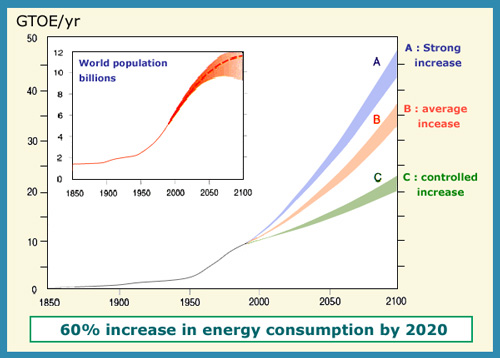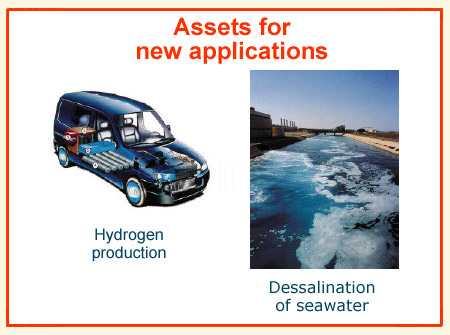Energy challenge : meeting energy demands of the Future
The emergence of huge future needs by developing countries will lead to a strong increase in energy demands. If every inhabitant of Southeast Asia were to consume in 2050 only half of what a European uses today (an American consumes twice as much!), that region alone would require more energy than the world needed in 2004: many billions tons of oil equivalent (Gtoe) a year. This unit used today to evaluate global energy needs, represents the energy equivalent of burning one ton of crude oil.
Despite the efforts being made in developed countries to conserve energy, a doubling of the world’s energy consumption by 2050 is almost inevitable.

Growing energy demands:
We are today far more numerous than either our parents or our grandparents were, and as a result we consume more energy. This trend is likely to continue until the year 2100 as shown in these charts of the projections of population and energy consumption worldwide.
© IN2P3
The energy sources available today will not be alone able to provide such a doubling. 75% of today’s fuel is based on finite reserves of natural gas, coal and petrol, whose combustion leads to massive emissions of greenhouse gas that causes global warming of the earth whose consequences are difficult to predict. If current rates of consumption continue, the end of the cheap supply of petrol is scheduled by 2020, that of natural gas by 2040, and that of coal within the next two hundred years at the current consumption levels. Even if the production of natural fuel stabilises at its current value of 7.5 billion tons of oil equivalent (7.5 Gtoes), another 10 Gtoe will need to be found through other means.
It is still not certain whether renewable energy sources (some of which are intermittent) are up to the challenge. The enormous quantities of energy needed means that nuclear fission may have to play a role in powering our future in conjunction with renewable energy sources. Nuclear fission (responsible for 6% of the world’s energy in 2003) is a major technology available that can theoretically serve as a replacement. However, to provide 5 Gtoe, only half the necessary energy, would require to multiply ten times the number of nuclear power plants by 2050.
Before it becomes a primary energy source, however, nuclear technology must evolve considerably. Resources in fissile uranium are also limited. A new generation of more efficient reactors needs to be designed. Today reactors are powered by uranium 235, the only fissile isotope of uranium found in nature, which is present at a rate of only 0.7% in uranium ore. The accessible reserves of uranium are currently estimated at 16 million tons. Thus supply would quickly runs out if we were to increase the number of power plants by a factor of ten and rely only on uranium-235.

Possible new applications
Some new types of reactors may offer applications outside the traditional field of electricity production. High-temperature reactors could one day separate molecules of hydrogen for use as a replacement for automobile fuel, and the heat produced could be used to desalinate sea water.
© CEA/Source J.M.Cavedon
The current generation of thermal reactors burn mainly uranium 235. Only 30% of their power comes from uranium-238 after its transmutation into plutonium. The development of MOX fuels (mixed oxides of plutonium and uranium) has increased the amount of plutonium that can be consumed, but the improvement in efficiency is limited.
It is still possible to exploit much more of the energy present in fertile nuclei such as uranium 238 or thorium 232 by using breeder reactors capable of producing more fissile matter than they consume. This will require developing new ‘closed” fuel cycles, with their manufacturing, burning and reprocessing steps, leaving only to radioactive waste the fission products behind. The amount of fuel needed to power such these breeder reactors would be greatly reduced, as only one ton of fissile matter would be needed to power a 1GW reactor for a year.
If the share of nuclear energy increases, other challenges lay ahead for the new reactor designs : improved safety, improved proliferation resistance and reduced volume of radioactive waste.
Other articles on the subject « Future Reactors »
Generation III Reactors
The reactors of tomorrow before those of after tomorrow Designed in the 1990s, third-generation r[...]
EPR Reactors
EPR: a third generation pressurized water reactor Third generation reactors are reactors intended[...]
Generation IV
Towards a fourth generation of reactors To meet the formidable challenges of sustainable developm[...]
Molten Salt Reactors
Promising reactors … but in a remote future Molten Salt Reactors are very different in desi[...]